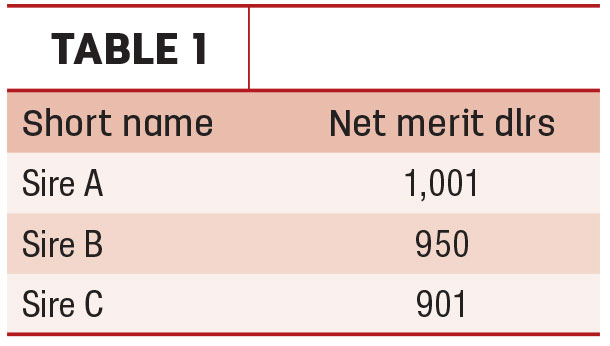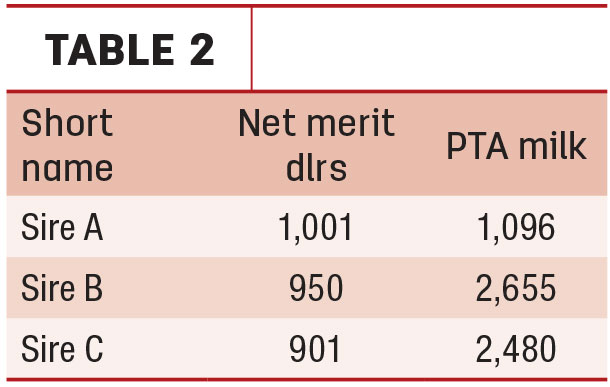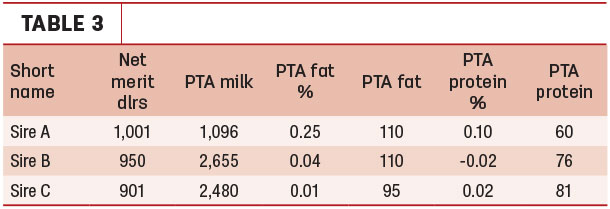What are your choices when mating A.I. sires to the dairy cattle in your herd? Do you use one of the mating services? Focus on Net Merit Dollars (NM$)? Or simply want to get the cow pregnant because you know that nine months from now she will drop a calf and start all over again on the lactation curve?
Breeding decisions made today have a tremendous effect on your future bottom line. So I hope that we are past simply getting the cow pregnant.
I’m here to suggest that you take a look at how you currently market your milk – or more importantly, how you will be marketing your milk in the future to determine the emphasis of your breeding selection.
Yes, it is at least two and a half years before today’s decision ends up producing saleable milk. But if you need to make changes 30 to 36 months from now, it will only cost you even more money as you replace cows with ones that will suit your marketing needs.
When it comes to making genetic selections, it’s not uncommon for producers to choose a composite index like NM$ or Cheese Merit Dollars (CM$). And in general, choosing sires based on these criteria will improve your herd. But can we make more progress by looking at specific components or PTA milk to improve the bottom line?
Net merit can be dicey
Several years ago, I had the opportunity to sit in on a presentation by an A.I. company rep that opened my eyes on net merit. He compared three bulls; an example is noted in Table 1.

When asked which one was the best bull, the crowd agreed that it was Sire A.
Then another field was added (see Table 2).

Now the crowd was not so sure that sire A was the best bull anymore. Choosing Sire A meant you were willing to sacrifice a lot of milk.
And when given all of the production indexes (see Table 3), Sire B may be the best bet – you get the most milk, the most pounds of fat and the second most pounds of protein.

But don’t we get paid for components? And won’t Sire A give us the highest components? Don’t fall into that trap. While there is a lot of variation in how dairies are paid for their milk, in most cases, you are paid for pounds of components. So while Sire A has the highest percent fat and protein, because of the added volume of milk with Sire B, you end up with as many pounds of fat and even more pounds of protein – even though Sire B is negative for percent protein.
There is a lot of talk about net merit or the breed performance indexes as the appropriate composite trait to use as the selection criteria. Just remember, only about 40 percent of the net merit formula is based on production. And the last time I looked, no one gets paid for their milk on net merit.
In the early days of the net merit formula, production indexes comprised 75 percent of the formula with Productive Life (PL) and Somatic Cell Score (SCS) comprising the rest of the value. Over the years, less and less emphasis has been placed on production in the net merit formula. That is not to say that the other parameters such as PL, SCS, Daughter Pregnancy Rate (DPR), feet and legs, body size, etc. are not important – they are. But the genetic progress that you make with a shotgun approach will most likely be less than targeting several well-placed indexes.
Components determine the milk check
Which brings us to the subject of this article – make your breeding decisions based on your milk market. In the old days, milk was priced per hundredweight with a slight differential for butterfat. In most cases, that system incentivized making as much fluid milk as possible.
But times have changed. Most milk today is priced on pounds of components sold – that is fat and solids-not-fat, some sort of cheese yield pricing or multiple component pricing. But in every case, you are paid on pounds of components produced.
So the next question for you is what cow will bring you a bigger milk check? The 25,000-pound cow with 4 percent butterfat and 3.5 percent protein, or the 30,000-pound cow with 3.2 percent butterfat and 2.8 percent protein? The first cow generates 1,000 pounds of fat and 875 pounds of protein, while the second cow in the example generates 960 pounds of fat and 840 pounds of protein. Clearly, in this case, the first cow generates more pounds of saleable product. In addition, you can save some dollars on freight because there are fewer fluid pounds to be shipped.
So the key is to evaluate how you are getting paid (or how you will be getting paid) and breed for the pounds of components (in a multiple component pricing scheme) that will maximize your production dollars.
You don’t want to neglect some of the other parameters: A cow still needs to get pregnant (DPR); she still needs to be able to walk from the bunk to the milk barn (feet and legs); and you need an udder that can be milked in a high-flow milk barn (udder composite). But given acceptable levels for the type traits, chase the pounds of components. In many cases, when the pounds of components increase, so do the pounds of milk – so you are really killing two birds with one stone by choosing the components as a key part of your selection logic. ![]()

-
Bill VerBoort
- General Manager
- AgriTech Analytics






